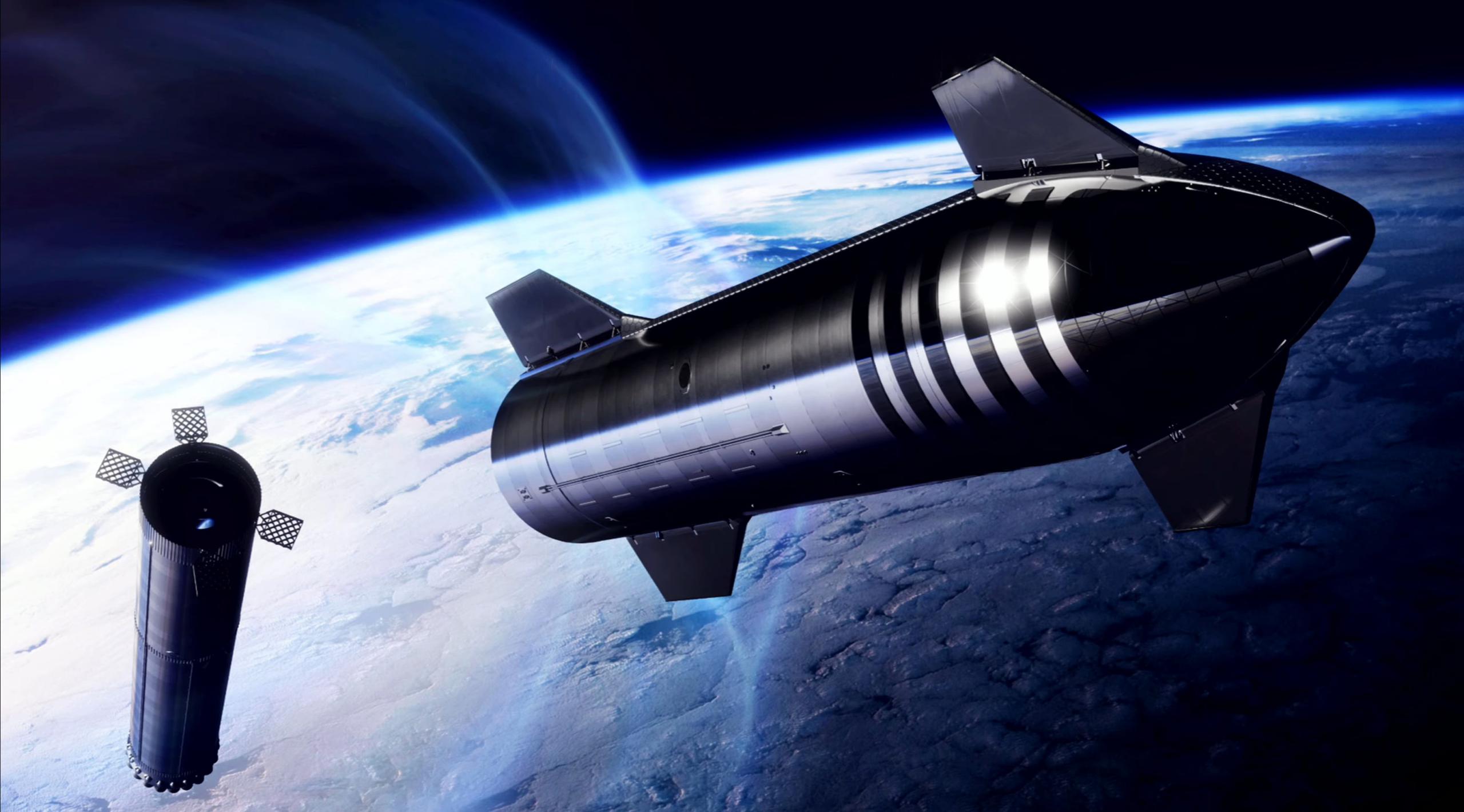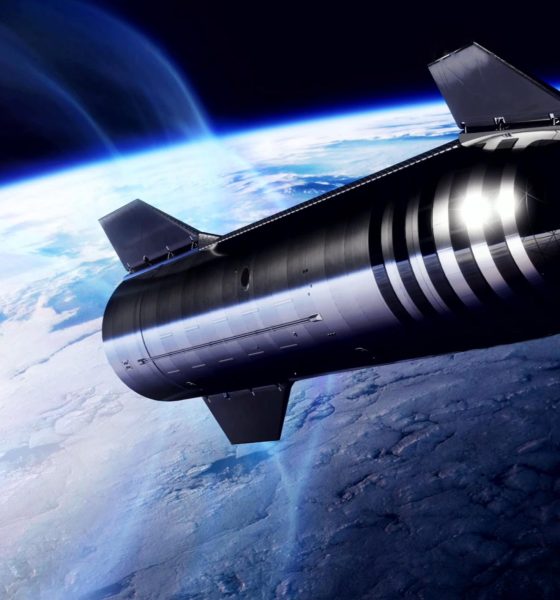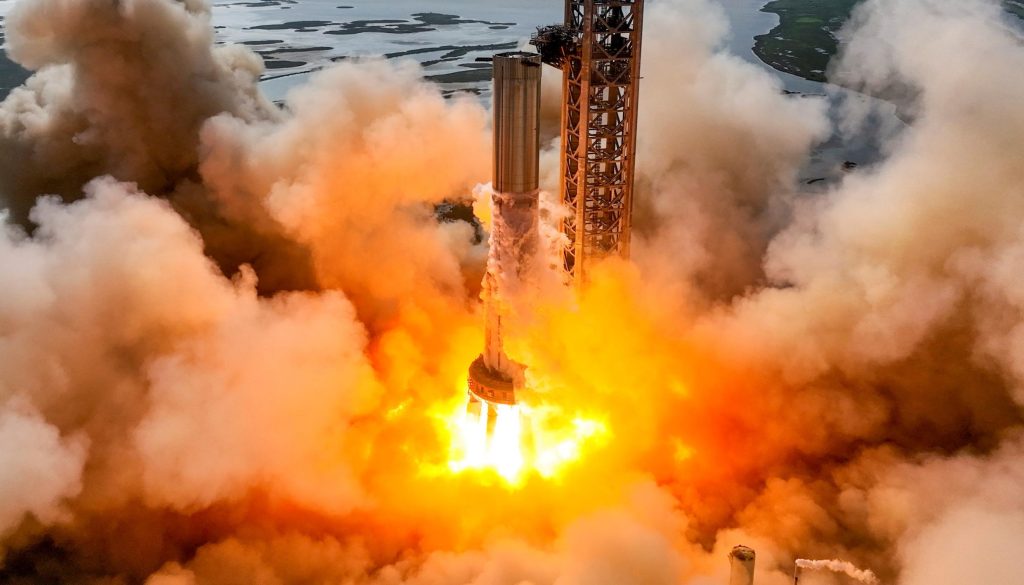

News
Elon Musk: SpaceX’s first orbital Starship launch “highly likely” in Q1 2023
SpaceX’s first Starship orbital launch mount (OLM) appears to have passed a busy week of stress-testing, clearing the way for the company to transport a finished Super Heavy booster to the pad.
Using the same launch mount, that Starship booster is expected to attempt to complete some of the riskiest and most challenging tests SpaceX has ever conducted at its Starbase rocket development facilities. The schedule for that testing is unclear, but after an unusually drawn-out period of qualification testing, Super Heavy Booster 7 (B7) could soon attempt a full static fire test of all 33 of its Raptor 2 engines. Either before or after that crucial test, SpaceX is also expected to install Ship 24 (S24) on top of Super Heavy B7 for Starship’s first full-stack “wet dress rehearsal.”
Ultimately, if that testing produces the results SpaceX wants to see, CEO Elon Musk says that Starship could attempt its first orbital launch as early as late February or March 2023.
We have a real shot at late February. March launch attempt appears highly likely.— Elon Musk (@elonmusk) January 8, 2023
The update that's rolling out to the fleet makes full use of the front and rear steering travel to minimize turning circle. In this case a reduction of 1.6 feet just over the air— Wes (@wmorrill3) April 16, 2024
Booster 7
Super Heavy B7 first left SpaceX’s Starbase factory in March 2022 and has been in a continuous flux of testing, repairs, upgrades, and more testing in the nine months since. The 69-meter-tall (~225 ft), 9-meter-wide (~30 ft) steel rocket was severely damaged at least twice in April and July, requiring weeks of substantial repairs. But neither instance permanently crippled the Starship booster, and Booster 7 testing has been cautious but largely successful since the rocket’s last close call.
Following its return to the OLS in early August, Super Heavy B7 has completed six static fire tests of anywhere from one to fourteen of its 33 Raptor engines. It has almost certainly dethroned Falcon Heavy to become the most powerful SpaceX rocket ever tested. And on January 8th, 2023, SpaceX rolled the rocket back to Starbase’s orbital launch site (OLS) for the seventh time. According to statements made by CEO Elon Musk and a presentation from a NASA official, the last major standalone test between Booster 7 and flight readiness is a full 33-engine static fire. Together, B7’s 33 Raptor 2 engines could produce up to 7600 tons (16.7 million lbf) of thrust at sea level, likely making Starship the most powerful rocket stage in the history of spaceflight.

Ship 24
Starship prototype S24’s path has been a bit less rocky. The ship has needed some less obvious repairs, particularly right after its first tests in May 2022. Since August 2022, Ship 24 has completed three static fire tests – all seemingly successful. Most importantly, one of those tests ignited all six of S24’s Raptor engines, potentially qualifying it for an orbital launch attempt. Most recently, SpaceX completed a series of mysterious repairs, replaced and static-fired one of S24’s engines, and removed the Starship from its test stand.
With Booster 7 now awaiting installation on Starbase’s orbital launch mount and Ship 24 near-simultaneously removed from its test stand, it appears that SpaceX may attempt a different test before Super Heavy’s full static fire. Instead, SpaceX could start by stacking Ship 24 and Booster 7 and conducting a full-stack wet dress rehearsal (WDR) before shifting focus to Booster 7’s riskier static fire.
A wet dress rehearsal is a routine test conducted before a rocket launch and is generally designed to simulate every aspect of a launch save for engine ignition and liftoff. Most importantly, that involves fully filling the rocket with propellant and passing all of the checks the same rocket would need to pass to be cleared for launch. For Starship, the largest rocket ever built, a full propellant load means filling both stages with an extraordinary ~5000 tons of liquid oxygen and liquid methane propellant. SpaceX also needs to fill the rocket fast enough to keep that propellant supercool, which increases its density and overall performance.
The first full-stack WDR will thus test Starbase’s launch facilities just as much as Booster 7 and Ship 24. SpaceX has conducted many several Starship WDRs, but not with Ship 24. It’s also never fully filled a Super Heavy booster with real propellant, let alone both stages at once. It’s likely that issues will be discovered as SpaceX pushes the envelope, likely requiring multiple attempts.
OLS
In the spirit of caution, SpaceX has even taken the unusual step of stress-testing Starship’s orbital launch mount with a custom jig. In the first week of 2023, SpaceX used that jig to load pairs of the OLM’s 20 hold-down clamps with hundreds of tons of ballast, ensuring that they can withstand the immense weight of a fully-fueled Starship. Proof tests of Super Heavy B4 and B7 have likely subjected the OLM to 2000+ tons of force, but a full Starship will weigh more than double the maximum weight the OLM has experienced to date.
Plenty of risk remains and SpaceX is trading speed for caution, but this extra-cautious step has likely reduced the risk of the launch mount’s structure failing during wet-dress and static fire testing. According to Musk, SpaceX has a “real shot” at preparing Starship for a “late February” orbital launch attempt. Nonetheless, Musk also implied that a full-stack WDR and 33-engine static fire would “probably” be completed “in a few weeks” in September 2022. What is clear is that SpaceX is more committed than ever before to avoiding a catastrophic failure during Starship’s first orbital launch attempt.

Elon Musk
Elon Musk and Tesla AI Director share insights after empty driver seat Robotaxi rides
The executives’ unoccupied tests hint at the rapid progress of Tesla’s unsupervised Robotaxi efforts.

Tesla CEO Elon Musk and AI Director Ashok Elluswamy celebrated Christmas Eve by sharing personal experiences with Robotaxi vehicles that had no safety monitor or occupant in the driver’s seat. Musk described the system’s “perfect driving” around Austin, while Elluswamy posted video from the back seat, calling it “an amazing experience.”
The executives’ unoccupied tests hint at the rapid progress of Tesla’s unsupervised Robotaxi efforts.
Elon and Ashok’s firsthand Robotaxi insights
Prior to Musk and the Tesla AI Director’s posts, sightings of unmanned Teslas navigating public roads were widely shared on social media. One such vehicle was spotted in Austin, Texas, which Elon Musk acknowleged by stating that “Testing is underway with no occupants in the car.”
Based on his Christmas Eve post, Musk seemed to have tested an unmanned Tesla himself. “A Tesla with no safety monitor in the car and me sitting in the passenger seat took me all around Austin on Sunday with perfect driving,” Musk wrote in his post.
Elluswamy responded with a 2-minute video showing himself in the rear of an unmanned Tesla. The video featured the vehicle’s empty front seats, as well as its smooth handling through real-world traffic. He captioned his video with the words, “It’s an amazing experience!”
Towards Unsupervised operations
During an xAI Hackathon earlier this month, Elon Musk mentioned that Tesla owed be removing Safety Monitors from its Robotaxis in Austin in just three weeks. “Unsupervised is pretty much solved at this point. So there will be Tesla Robotaxis operating in Austin with no one in them. Not even anyone in the passenger seat in about three weeks,” he said. Musk echoed similar estimates at the 2025 Annual Shareholder Meeting and the Q3 2025 earnings call.
Considering the insights that were posted Musk and Elluswamy, it does appear that Tesla is working hard towards operating its Robotaxis with no safety monitors. This is quite impressive considering that the service was launched just earlier this year.
Elon Musk
Starlink passes 9 million active customers just weeks after hitting 8 million
The milestone highlights the accelerating growth of Starlink, which has now been adding over 20,000 new users per day.

SpaceX’s Starlink satellite internet service has continued its rapid global expansion, surpassing 9 million active customers just weeks after crossing the 8 million mark.
The milestone highlights the accelerating growth of Starlink, which has now been adding over 20,000 new users per day.
9 million customers
In a post on X, SpaceX stated that Starlink now serves over 9 million active users across 155 countries, territories, and markets. The company reached 8 million customers in early November, meaning it added roughly 1 million subscribers in under seven weeks, or about 21,275 new users on average per day.
“Starlink is connecting more than 9M active customers with high-speed internet across 155 countries, territories, and many other markets,” Starlink wrote in a post on its official X account. SpaceX President Gwynne Shotwell also celebrated the milestone on X. “A huge thank you to all of our customers and congrats to the Starlink team for such an incredible product,” she wrote.
That growth rate reflects both rising demand for broadband in underserved regions and Starlink’s expanding satellite constellation, which now includes more than 9,000 low-Earth-orbit satellites designed to deliver high-speed, low-latency internet worldwide.
Starlink’s momentum
Starlink’s momentum has been building up. SpaceX reported 4.6 million Starlink customers in December 2024, followed by 7 million by August 2025, and 8 million customers in November. Independent data also suggests Starlink usage is rising sharply, with Cloudflare reporting that global web traffic from Starlink users more than doubled in 2025, as noted in an Insider report.
Starlink’s momentum is increasingly tied to SpaceX’s broader financial outlook. Elon Musk has said the satellite network is “by far” the company’s largest revenue driver, and reports suggest SpaceX may be positioning itself for an initial public offering as soon as next year, with valuations estimated as high as $1.5 trillion. Musk has also suggested in the past that Starlink could have its own IPO in the future.
News
NVIDIA Director of Robotics: Tesla FSD v14 is the first AI to pass the “Physical Turing Test”
After testing FSD v14, Fan stated that his experience with FSD felt magical at first, but it soon started to feel like a routine.

NVIDIA Director of Robotics Jim Fan has praised Tesla’s Full Self-Driving (Supervised) v14 as the first AI to pass what he described as a “Physical Turing Test.”
After testing FSD v14, Fan stated that his experience with FSD felt magical at first, but it soon started to feel like a routine. And just like smartphones today, removing it now would “actively hurt.”
Jim Fan’s hands-on FSD v14 impressions
Fan, a leading researcher in embodied AI who is currently solving Physical AI at NVIDIA and spearheading the company’s Project GR00T initiative, noted that he actually was late to the Tesla game. He was, however, one of the first to try out FSD v14.
“I was very late to own a Tesla but among the earliest to try out FSD v14. It’s perhaps the first time I experience an AI that passes the Physical Turing Test: after a long day at work, you press a button, lay back, and couldn’t tell if a neural net or a human drove you home,” Fan wrote in a post on X.
Fan added: “Despite knowing exactly how robot learning works, I still find it magical watching the steering wheel turn by itself. First it feels surreal, next it becomes routine. Then, like the smartphone, taking it away actively hurts. This is how humanity gets rewired and glued to god-like technologies.”
The Physical Turing Test
The original Turing Test was conceived by Alan Turing in 1950, and it was aimed at determining if a machine could exhibit behavior that is equivalent to or indistinguishable from a human. By focusing on text-based conversations, the original Turing Test set a high bar for natural language processing and machine learning.
This test has been passed by today’s large language models. However, the capability to converse in a humanlike manner is a completely different challenge from performing real-world problem-solving or physical interactions. Thus, Fan introduced the Physical Turing Test, which challenges AI systems to demonstrate intelligence through physical actions.
Based on Fan’s comments, Tesla has demonstrated these intelligent physical actions with FSD v14. Elon Musk agreed with the NVIDIA executive, stating in a post on X that with FSD v14, “you can sense the sentience maturing.” Musk also praised Tesla AI, calling it the best “real-world AI” today.








